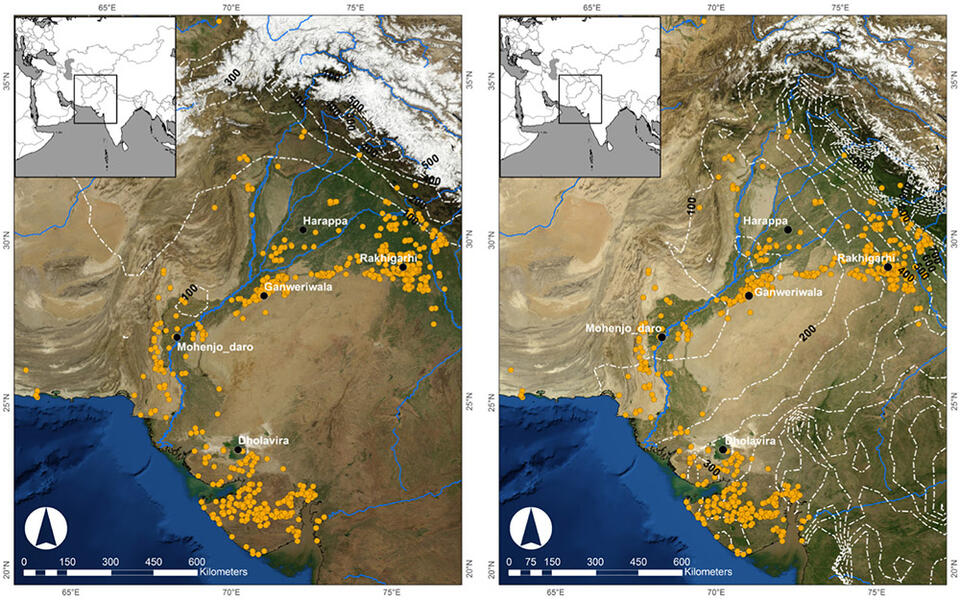A superb framing of how we might think of the Indus civilization and its evolution as a larger entity in comparison and contrast with other ancient civilizations. How did Indus cities fit into a rural context? Were they ruled by elites? How did they manage to survive so long? What can we say about the social or political system that held together such a vast realm in the absence of reading the Indus script?
There are no easy answers here, but Dr. Petrie reviews the evidence dispassionately and discusses the alternatives and possibilities that the record so far indicates. As he puts it, "This contribution assesses the dynamics of fragility, robustness, resilience and sustainability in the Indus Civilization. It provides an overview of urban and rural Indus settlements, then outlines the environmental contexts within which Indus urbanism developed, and reviews the evidence for how Indus populations were adapted to those environments. Debates about Indus social, economic and political structures within and between cities are reviewed, and the decline of Indus urbanism is considered" (p. 110).
There are so many paradoxes within the Indus civilization, particularly regional diversity vs. a "veneer" of uniformity: "While the populations living in the various regions were clearly interacting with each other, and sharing aspects of technology, material, ideas and ideology, it is becoming increasingly clear, however, that the indications of material uniformity across the Indus Civilization mask the degree of regional diversity in material and practices (Wright 2010; Petrie et al. 2017)" (p. 119).
On the question of elites, Dr. Petrie's summation of the evidence is similarly nuanced: "Taken together, these views suggest that no one elite group dominated any of the Indus cities in a strictly hierarchical fashion. Rather, the polycentric Indus cities may have been dominated by several groups that were potentially elite and broadly equal in term of socio-economic status, but who competed with each other and used mechanisms to limit concentrated power. This pattern may well hold for the smaller centres and towns as well, where segregation within individual settlements is often evident (Petrie 2013)" (p. 120).
Another issue he tackles is the nature of certain public, possibly religious buildings, though even these may have had different functions than those in other ancient civilizations. He also takes on the subject of warfare in those times, and compares it to other models. He writes that "the element of this definition that does not accord neatly with common perceptions of the Indus cities is the role of warfare, but Cork (2011) has pointed out that evidence for warfare is particularly rare in ancient societies, and a range of Indus material may actually have been weaponry (Cork 2005). I have suggested that a major difference between the Indus Civilization and other contemporaneous societies is in the representation of violence, which could be related to both ideology and the distance between centres (Petrie 2013, 95). Although workable, the model of peer polity interaction is not neatly suited to the Indus case, and the suggestion that there were heterarchical [unranked] relationships between the Indus urban centres may be more fruitful (Petrie 2013)" (p. 122).
An extensive discussion of what we know about the decline of the ancient Indus civilization is also presented, starting with the disuse of major structures at Mohenjo-daro, possibly as early as 2200 BCE, until "by c. 1900 BC different social, economic and political structures were in place" (p. 122). This is a very complex space to navigate, and includes variables like the possible changes in monsoon patterns, changes in other civilizations with which the Indus peoples traded and much more. The data is inconclusive, and much more work needs to be done here even if wholesale change is evident in many areas, and of course we know so little about political dynamics in the Indus cities and villages at the time, that drawing firm conclusions is very difficult at this stage. Dr. Petrie also stresses the enormous resiliency and adaptability to environmental factors of Indus cities and villages across many centuries, which suggests that internal more than external factors may have finally led to final the abandonment of all urban centers except for Harappa.
In short, a highly informative and thought-provoking discussion (and extensive bibliography for further reading).
Image: Maps of the Indus River Basin showing the distribution of modern winter (left) and summer (right) across the area occupied by the Indus Civilization, in relation to the distribution of urban period settlements (orange circles), and urban centres (black circles) (image C.A. Petrie).

